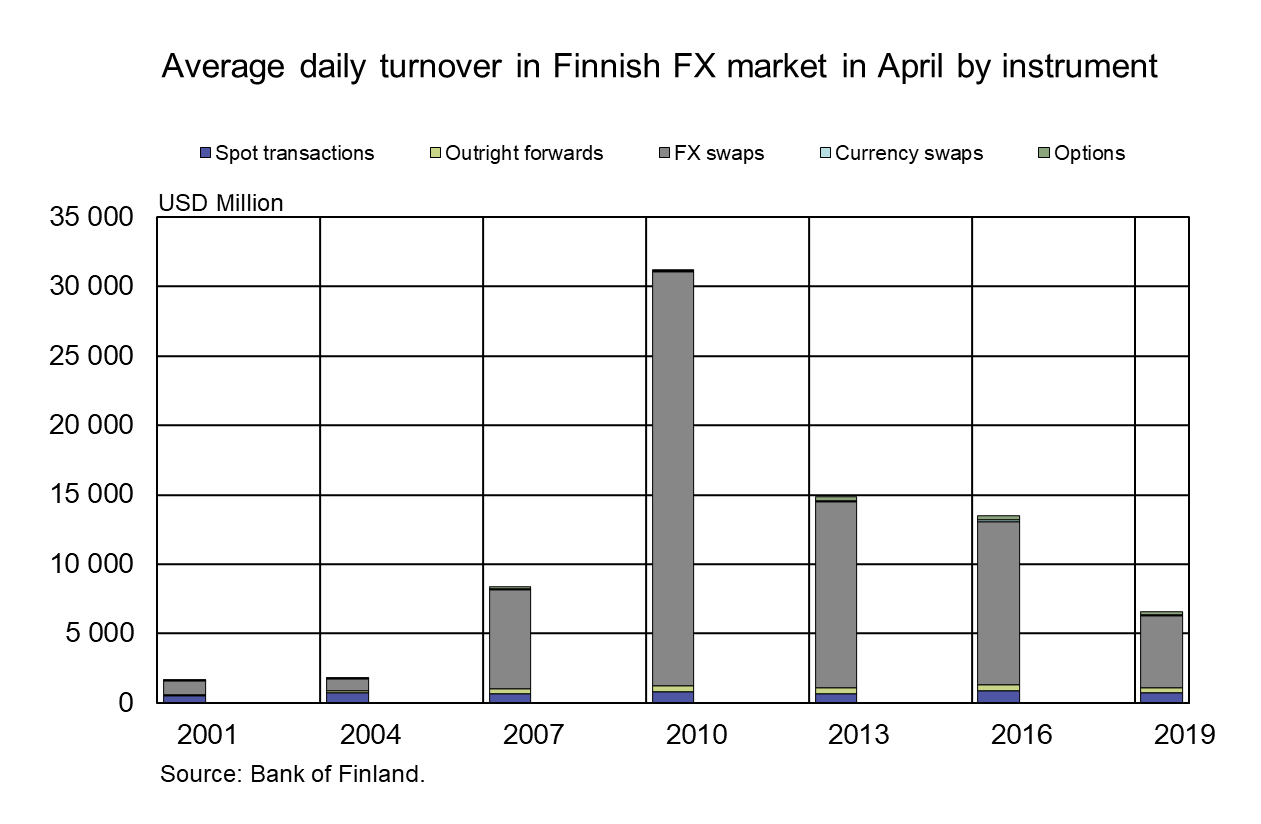April 2019 saw the lowest daily turnover in the Finnish foreign exchange (FX) market since 2004.1 The average daily FX turnover for financial institutions operating in Finland declined to less than a half, from USD 13.5 billion in 2016 to USD 6.6 billion this year. A similar trend has also been observed in the other Nordic countries. Global FX trading, in turn, has increased by USD 1,500 billion (29%) from April 2016. This information comes from the triennial survey of foreign exchange and OTC derivatives markets conducted by the Bank for International Settlements (BIS) and implemented in Finland by the Bank of Finland.
The decline in the daily FX turnover in Finland is almost entirely due to a contraction in FX swap transactions. Nevertheless, swaps remained the largest instrument category, accounting for 79% of all FX transactions of financial institutions operating in Finland. Spot transactions accounted for 11%, outright forwards for 6% and OTC options for 4% of the Finnish FX market. FX swaps were also the largest instrument category in global terms.
As in the previous years, the United Kingdom and the United States were the largest of the world’s top five FX centres, followed by Hong Kong, Singapore and Japan. The FX market grew at a rate above the global average in the United Kingdom and Hong Kong. Of the global FX transactions conducted in April 2019, the United Kingdom accounted for 43%.

In addition to FX trades, the BIS survey also collects data on daily turnovers in OTC interest rate derivatives in US dollar terms. The average daily turnover in these instruments in Finland has grown by 60%, averaging USD 3.6 billion in April 2019. Globally, turnover in OTC interest rate derivatives grew from 2016 by as much as 143%, corresponding to an average daily turnover of USD 6,500 billion.
OTC options2 were exceptionally the most actively traded instrument category of OTC interest rate derivatives in Finland. Interest rate swaps, which usually rank first, were now the second most traded instrument type. Globally, there were no marked changes in instrument-specific trading volumes, and interest rate swaps were still by far the largest instrument category.

The euro maintained its role as the most actively traded currency in the Finnish FX market. It was the counterpart currency in 93% of all contracts. The share of the US dollar as a counterpart currency has declined from 67% in 2016 to 58% in April 2019. Globally, the share of the US dollar remained unchanged at 88%, while the share of the euro rose to 32% and the share of the Japanese Yen fell to 17%. Nevertheless, the Japanese Yen remained the world’s third most actively traded currency.
The majority (58%) of FX trades in Finland were conducted between the financial institutions participating in the survey, although the share of non-financial institutions as counterparties has increased. The share of domestic counterparties has also increased, to 37% in April 2019.
For further information, please contact
Ilona Vänni, tel. + 358 9 183 2603, email: ilona.vanni(at)bof.fi.
The press release by BIS and the results of the global survey can be accessed on the BIS website at https://www.bis.org/publ/rpfx19.htm.
1Due to changes in the reporting population and reporting financial institutions’ organisational changes, the figures for 2019 are not fully comparable with the data for 2016 in respect of Finland.
2Including also instruments other than outright forwards and swaps.